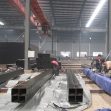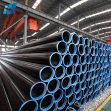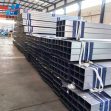Galvanized Rigid Steel Conduit
Generally, rigid steel conduit is manufactured from mild steel tube, which has an accurate circular cross section, a uniform wall thickness, a defect free interior surface, and a continuous welded seam. The interior and exterior surfaces are thoroughly and evenly coated with zinc through the hot dipped galvanized process, in order to form the galvanic protection against corrosion. A clear coating of zinc chromate is also applied. Additional lubricating coating may be applied to the interior surface to reduce friction during wire insertion.

Galvanized Rigid Steel Conduit (GRC, RMC) is the heaviest weight and thickest wall of electrical conduits. In the practical applications, how to choose the proper type of steel pipe for the installation indoors or outdoors, in dry or wet locations, exposed or concealed atmospheric conditions, mainly requires certain professional knowledge as well as other considerations before your project. In addition, GRC conduit is a raceway solution which allows for future wiring changes and delivers remarkable mechanical protection to conductors and cables.
Technically, there are several similarities and differences between galvanized pipe and rigid metal conduit. Galvanized pipe and rigid metal conduit are both very versatile but designed for different applications. Both types of piping ends are easily machined to include such features as threads. Specifically, galvanized pipe can be manufactured to almost any diameter, while rigid metal conduit is available in diameters between 1/2 inch and 6 inches. Conduits are typically designed to 10-foot lengths. Galvanized piping can be machined to feature threads or couplings on the ends. Rigid metal conduit is designed with one coupling end and one threaded end. Rigid metal conduit threads are fitted with a color-coded threat protector component to keep the threading sharp and also indicate the size of the pipe.
Besides, most galvanized steel pipe has a typical galvanized coating on the surface of pipe body. This method involves immersing a material in a zinc bath, effectively creating a corrosion-resistant surface on the material. Most of the rigid metal conduit on the market has been galvanized to increase corrosion resistance.
Galvanized pipe can be widely used for pipelines in some projects. Rigid conduit lines are designed specifically for electrical applications. They offer excellent protection for the electrical wires that are run through them. Both types of piping are designed for indoor, outdoor and underground applications.
For any further information, you can visit our official website. Or Contact Us at your convenience.
Tel: +86 18202256900 Email: steel@fwssteel.com










